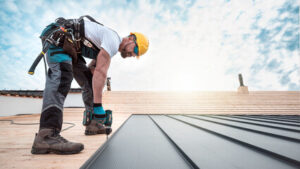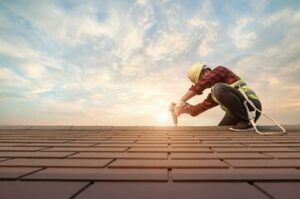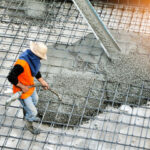Home » Roofing
Category Archives: Roofing
The Importance of Proper Roofing Installation
A roof is one of the most crucial parts of any home, providing protection against weather and nature’s elements. A proper roofing installation will ensure that this vital protection is intact for years to come.

Whether you’re a new homeowner or a professional roofer, a few simple tips can help ensure the success of your roofing project. Visit https://wwwcedarparkroofingpro.com to learn more.
The roof’s material is one of the most significant decisions to make during roofing installation. A top-tier roofer will be able to walk homeowners through the wide array of options that best suit their goals, home architecture and budget.
Asphalt shingles are the classic roofing material that most people recognize, and they come in many different shapes, sizes and colors. This affordable option is easy for most roofers to install, and it offers good protection against water infiltration and UV rays.
Concrete and clay shingles or tiles are durable options that can last for hundreds of years. They are able to withstand 120 mph winds, shingle uplift and considerable hail impact, making them a smart choice for harsh climates. They are also resistant to fire, which can cause problems with other roof materials.
Rolled asphalt is another roofing material that’s easy for most roofers to work with. It comes in rolls and is adhered to the roof with an adhesive. This is a cost-effective option that can last for around 10 years.
Modified bitumen is a popular roofing material that’s used on flat roofs. It is composed of plies that are saturated with bitumen and delivered to the roof in rolls. It is usually made with either coal-tar or petroleum-based bitumen, and it’s often used for dead-level and low-slope roofs. It is not a good choice for steep-sloped roofs, as it can leak and is difficult to find leaks.
Slate is an incredibly beautiful and long-lasting roofing material. It’s not typically used on new homes, but it’s still seen on some older structures. It’s extremely heavy, though, so it can put a lot of stress on the structure of the house and can be expensive to install. It’s also susceptible to punctures and requires regular maintenance.
Tile is an elegant and sophisticated option that’s a great fit for homes with Mediterranean or Spanish architecture. It is a durable material that isn’t damaged by extreme cold, but it does need to be resealed regularly and may require additional protection in high wind areas.
Inspection
The inspection process for roofing installation is an essential part of ensuring quality and compliance with regulatory standards. It consists of purposeful visual observation and careful attention to detail. The process can be facilitated by using digital tools, such as mobile application software, to document inspection findings and share them with employees across the enterprise. The ability to standardize and automate inspection processes reduces the risk of error and helps businesses attain their goals efficiently.
During the initial consultation and inspection, a roofing contractor will assess the condition of your roof to determine its strengths and weaknesses. They will also discuss your needs and preferences for materials and solutions. This information will help them create a custom proposal for your project.
Before starting shingle installation, roofers will prepare the area by clearing debris and setting up safety measures. This includes covering plants, setting up scaffolding if needed, and taking other precautions to protect your home from damage and ensure the safety of workers. Then, they will strip the old roof and repair any problems. This is important because the presence of rust or other materials can transfer to the new roof, creating a defective surface that will need to be replaced.
Next, a layer of underlayment, such as tar paper or felt material, is installed over the roof deck. This creates a barrier that protects the roof from water infiltration and prevents leaks. Flashing is also installed around critical areas, such as chimneys, vents, and skylights, to prevent water leakage. Finally, starter and main shingles are placed correctly, and the edges are sealed with caulking.
Once the roof is complete, a final inspection is performed to ensure that all work meets quality standards. Then, the roof is cleaned up and the work area is cleared. Your roofing contractor will also provide you with any documentation and warranties that are associated with your new roof. They may also schedule a follow-up visit to ensure that your roof is functioning properly. It is important to hire a professional roofing contractor for your roofing project, as they have the knowledge and experience needed to install your roof properly.
Permits
In many areas, building regulations dictate that homeowners and contractors obtain the proper permits before starting construction. This includes re-roofing. The specifics of whether or not a permit is required tend to vary by state, city and county. A quick internet search for “re-roofing” and your municipality will likely provide you with the relevant information.
While it may seem like red tape that is there simply to add to the work, these requirements help ensure that builders adhere to local codes and are using the right materials and building properly. This is important for the safety of all residents and to protect your home from future damage or issues.
Having a permit also allows you to request an inspection once the project is nearing completion. It gives you peace of mind that the work has been done to code and will stand up to any resale inspections in the future.
The process of getting a permit generally requires you to submit plans that outline the scope of work. Your contractor should be able to handle this step for you, as they are often familiar with the process and local requirements. If they do not, ask them about the process and how long it typically takes to get a permit.
One other question you should ask potential roofers is how they plan to dispose of waste products during the re-roofing process. All construction sites produce some sort of waste, and it is essential that this material is disposed of properly per your city or county’s ordinance.
You can learn more about the roofing process by contacting a licensed company in your area. They will be able to give you more detailed information about the work that is involved, as well as the costs of the project. A good roofing company will have the necessary licenses and insurance to cover any potential damages or injuries that may occur during the re-roofing or installation of the new roof.
Replacing a roof is a significant investment, so you want to make sure that the work is completed correctly and to your satisfaction. Choosing the right roofing company can save you time, money and hassle in the long run.
Timeline
The duration of a roof replacement project is influenced by various factors, including the size of the house and material type. The installation process also depends on the crew’s level of experience and weather conditions. In addition, local building codes and the need to obtain permits can introduce additional delays into a roofing timeline.
The initial consultation is crucial for choosing the right roofing materials and establishing a realistic timeline. During this stage, the contractor will take measurements and discuss the scope of work with the client to create an accurate estimate. This information is then used to develop a plan for the project. The next step is removing the old roofing material and preparing the surface for new materials. This can add a few days to the overall project timeline. If the roof is in poor condition, this may be a significant undertaking that requires repair or replacement of existing decking and supports.
On install day, the roofers will start constructing the new roof. Depending on the size of the house, this typically takes one to two days. If the roof is complex, such as a Victorian-style home with multiple valleys and varying angles, it will take longer than a simple sloped roof. This is due to the extra work needed for safety and precision when cutting exact pieces to fit tricky spots.
During this phase, the roofers will also install any flashing required, such as around chimneys, wood stove pipes, vents, and roof valleys. In some cases, these pieces are custom-made and can add a few days to the overall construction time. Additionally, if the homeowner chooses to add additional ventilation openings, these can add another day or more to the overall installation timeline.
The final steps include cleaning up the site and performing a thorough inspection to ensure quality and compliance with local codes. During this process, the contractor will also take measurements and inspect for any potential issues with the underlying structure that need to be addressed. This can add a day or more to the overall timeline, but it is critical for ensuring a high-quality new roof.
Choosing a Roofing Contractor
Choosing Murfreesboro Roofing Contractor is an important decision that can ensure your roof installation project goes smoothly. Asking questions about past projects, safety protocols, and warranties is critical to finding a reliable contractor.

Look for contractors that offer client references and testimonials. These provide genuine insights into a contractor’s quality and reliability.
Roofing contractors can help homeowners save money on their roofing installation or repair projects by providing materials at a discount and helping to avoid costly future repairs. However, a homeowner should compare quotes from several different roofing contractors to ensure that they are getting the best value for their money. Labor costs vary by region, and factors such as roof complexity and steepness of pitch can increase cost. Homeowners should also ask for detailed estimates that include material costs, labor, and waste disposal fees.
Choosing a local contractor will keep money in the community, which can be beneficial to small businesses and the overall economy. In addition, a local contractor will likely be more familiar with the local building codes and permit requirements for new construction or roof replacement.
Reliability
Homeowners should assess a contractor’s reliability by reviewing credentials, customer feedback, and warranty offerings. Taking a comprehensive approach to selecting a home roofing contractor ensures quality work and peace of mind throughout the project and beyond. A reliable contractor will provide transparency through detailed estimates and will offer flexible financing options to meet various budget needs. Detailed written estimates help prevent misunderstandings and serve as a reference point for the duration of the project.
Homeowners must also consider a contractor’s safety protocols. A reliable contractor will prioritize the safety of their workers and property, which minimizes disruptions and liability risks during the roofing process. Inquire about a contractor’s safety training programs and certifications to confirm that they adhere to industry standards.
During the selection process, homeowners should also verify a contractor’s licenses and insurance coverage. A valid license indicates that the contractor meets industry standards and complies with local regulations. Moreover, insurance coverage protects homeowners from liability in the event of accidents or damages during the project.
Reputable contractors will provide references from previous clients. Contacting these references can help homeowners gauge a contractor’s track record, quality of work, and professionalism.
Lastly, a reliable roofing contractor will provide warranties for their products and workmanship. These warranties should be clearly explained, including terms such as workmanship, prorated coverage, transferability, algae protection, and manufacturer defects. Homeowners should also inquire about any conditions or restrictions that may affect the validity of these warranties.
Experience is another important factor when selecting a roofing contractor. A contractor with several years of experience is likely to have encountered a variety of roofing challenges and developed effective solutions. In addition, a contractor with an established business is more likely to be around for any future warranty or maintenance issues.
In addition to assessing a roofing contractor’s credentials and insurance coverage, homeowners should review their history of business practice and financial stability. This will help them determine a contractor’s ability to fulfill their obligations under the contract. Additionally, a trustworthy roofing contractor will be transparent about their pricing structure and work processes. Lastly, homeowners should request a copy of the contract and contact the insurance provider directly to verify coverage details.
Expertise
Choosing the right roofing contractor is critical to the success of your project. A reputable company will provide a detailed estimate and timeline, and can also handle any issues that arise during the project. They will also work with you to find solutions that fit your budget. They will also be transparent about any additional costs that may come up during the process. Additionally, they will make sure that their workers are safe and follow all industry standards.
Roofing contractors can help with both residential and commercial projects. Whether you need new roofing materials installed or an existing roof repaired, they can help you figure out what type of material will work best for your situation. They will also recommend the best roofing products for your climate and offer suggestions that fit within your aesthetic preferences.
When looking for a roofing contractor, look for a local company that has extensive experience in the area. This will ensure that they are familiar with the area’s unique challenges and can address them effectively. You should also check their reputation online and ask for references.
A good roofing contractor should be licensed, insured, and bonded. They should also have a portfolio that includes previous projects. This will allow you to see their quality of work and how it matches your expectations. Additionally, you should check the BBB website to see any complaints against them.
Lastly, you should ask about the company’s warranty policy. It is important to know if they have a transferable warranty, which will protect you if you ever decide to sell your home. You should also ask about the length of the warranty and what types of coverage are included.
Moreover, a good roofing contractor should have dedicated employees and a comprehensive service package. This will include the installation of gutters, shingles, and insulation, as well as repairing or replacing damaged roof-deck attachments. They should also be able to handle the repair of wood sheathing and fascia as needed during roof repairs or replacement. In addition, they should have a good understanding of the roof structure and be able to perform inspections to determine any potential problems.
Marketing
The roofing industry is a competitive one, and contractors need to implement effective marketing strategies to attract customers. This involves optimizing a website for search engines, improving the user experience, and creating quality content that showcases roofing expertise. It also involves implementing effective calls-to-action (CTAs) that direct visitors to take the next step, whether it is requesting a quote or signing up for a newsletter. In addition, it’s important to focus on local SEO and engage with potential clients through social media platforms.
Using CRM Tools: CRM systems help roofing contractors manage leads and streamline the sales process. These tools allow them to record client information, set reminders for follow-up, and track the status of each lead. This helps ensure that no potential client is missed or forgotten. Moreover, they can also help roofing contractors track their ROI and make improvements to their sales processes.
Providing Excellent Customer Service: Customer satisfaction is essential for any roofing contractor. This can be achieved by communicating clearly with clients throughout the project, addressing any issues promptly, and following up after project completion. Additionally, roofing contractors should be willing to provide references and proof of their qualifications and expertise.
Offering Referral Discounts: Several marketing strategies can be used to encourage client referrals. These can include a percentage off on future projects or cash incentives for each referral. These strategies can be promoted via social media and other channels, and can greatly enhance a roofing contractor’s bottom line.
Manufacturer Relationships: Roofing contractors should build strong relationships with manufacturers to gain access to expertise, services, and products. They can do this by leveraging their websites, attending local events, and participating in online forums. They should also ask manufacturers for support on specific projects, including ensuring compliance with insurance company documentation and replacement thresholds.
To further expand their reach, roofing contractors can use paid advertising to target specific demographics. They can also use their websites to showcase photos of past roofing projects and share customer testimonials. Finally, they can add value to their website by sharing helpful roofing tips and providing relevant infographics. This will not only help their search engine optimization (SEO) efforts, but will also increase their engagement and conversion rates.
When to Call a Roofer for Skylight Repair
Skylights are a beautiful and practical addition to any home, providing natural light and ventilation. But like any home feature, they require regular maintenance and occasional repair to function properly. Contact Skylight Repair Las Vegas NV for professional help.

Water damage caused by leaky skylights can escalate quickly if left unattended, resulting in major mold growth and structural issues that require immediate action.
Skylights bring natural light into a home, but they can also leak water and cause damage. There are several causes of skylight leaks, including improper installation or sealant failure, and it’s important to catch them early before they cause serious problems. Water stains on the ceiling or walls near a skylight are a clear indicator of moisture penetration. Mold and mildew growth are another sign of leaks. If left unchecked, these signs can lead to structural deterioration and expensive repairs.
Identifying and fixing leaking skylights is relatively easy if homeowners know what to look for. First, it’s necessary to locate the source of the leak. This usually means performing a visual inspection and testing out the area with a hose to simulate rain. Once the source is located, it’s essential to clean the area and remove any debris that may have caused the leak. This will help ensure that any new sealants or roofing cement adhere properly to the surface.
One of the most common causes of skylight leaks is a poor caulked seam. This is typically a result of improper installation or poor quality materials, and it can allow moisture to seep into the home through the roof. If a homeowner notices this issue, they should consult a professional to resolve it before it worsens.
Other potential issues with skylights include poor ventilation and problems with the shingles around them. This can lead to a clash between indoor and outdoor temperatures, which results in condensation and harmful mold. This problem can be avoided by ensuring that the dome and glass are well insulated, and by maintaining proper ventilation.
It’s also a good idea to perform routine maintenance on a regular basis, as this can prevent many of the most common problems that lead to skylight leaks. This includes checking the metal framing to make sure it’s secure and not showing signs of wear and tear, as well as cleaning gutters to avoid overflow and water spillage onto the skylight. It’s also a good idea to trim any overhanging branches that could fall on the skylight and block the water drainage path.
Cracks
A cracked skylight is an obvious sign that it’s time to call a roofer for repairs. If left unaddressed, cracks can lead to moisture infiltration and structural damage, and they’re also a significant safety concern. Cracks are most likely to occur in glass skylights, especially those with older single-pane glazing. The resulting water leaks can travel along beams and through insulation layers before dripping onto ceilings or walls below the skylight.
Aside from causing serious structural problems, leaking skylights can compromise your home’s energy efficiency. If a crack allows air to escape, your heating and cooling systems will have to work harder to maintain the right temperature, which can lead to higher energy bills. Additionally, a crack in the glazing can allow moisture into your home, which can lead to staining, mold, and other issues.
If the crack is caused by a faulty seal, it’s usually a simple DIY fix. Using a high-quality silicone sealant can help to prevent future leaks and ensure that the repair lasts. If the crack is caused by a damaged frame or flashing, however, it may be more difficult to repair without professional help.
A leaking skylight can be caused by many factors, including poor installation, weather conditions, or structural stress. Leaks are more common in fixed skylights than in openable skylights, because the opening is more vulnerable to moisture and debris. It’s also possible that the leak is caused by a problem with the flashing or the skylight pane itself, and either case, it’s important to have the issue repaired promptly.
Aside from affecting your home’s energy efficiency and causing water leakage, a cracked skylight can also detract from its visual appeal. Replacing a cracked skylight can restore its beauty and add value to your home.
Structural Issues
Skylights are beautiful additions to any space, allowing natural light to flood indoor spaces while connecting occupants with the outdoors. They can enhance a building’s aesthetic and add value to a property, but they also require regular inspection and maintenance to ensure that they are functioning properly. Over time, skylights can develop a variety of issues that impact their functionality and safety, including water leaks, structural damage, and discoloration. Addressing these issues promptly will prevent interior damage and improve energy efficiency.
Leaks are perhaps the most common skylight problem. Even a small leak can cause serious problems such as mold growth and water damage to ceilings and walls. Detecting a leak can be difficult, but looking for damp spots or discoloration in the area around the skylight can be an indicator. If you notice any of these signs, it’s best to contact a professional for immediate inspection and repair.
Often, the root of the issue is related to the flashing that seals the edges of your skylight on the roof. When the flashing becomes cracked, corroded, or damaged, it can become an entry point for water and create an opening for further damage to your roof and ceiling. A qualified roof technician can repair or replace the flashing to restore your skylight’s waterproof capabilities and protect your home from the elements.
Other skylight issues include cracks and chips that develop due to wear and tear or extreme weather conditions. While minor, they can still serve as entry points for water and should be repaired as soon as possible to minimize further damage. Seasonal considerations also play a role, with winter snowfall causing cracking of the glass or frame, and hot summers resulting in warping of the frame or seal failure.
Skylights provide a great advantage to commercial buildings by improving natural light and ventilation and reducing energy costs. However, leaks and structural damage can result in poor insulation properties, requiring higher heating and cooling costs and contributing to discomfort for occupants. By conducting regular inspections and following a structured repair process, skylights can be made more resistant to environmental stressors, optimizing their performance and lifespan.
Replacement
Skylights add natural light and fresh air to interior living spaces. They also help maintain an energy-efficient environment and reduce cooling costs during hot weather. However, these roof accessories can present some challenges when they begin to show signs of wear and tear. The most common issue is leakage. If you notice water stains on your ceiling or walls around the skylight, it’s time to call for repair. Leakage is typically due to poor installation or faulty seals. The best way to avoid leakage is to ensure your skylight is properly insulated and ventilated. In addition, you should inspect the skylight regularly to check for any damage that could lead to leakage.
Another sign that it’s time for skylight repair is condensation. While some condensation is normal, excessive moisture can lead to mold growth and deteriorate the structure of the roof and ceiling. Moisture build-up can also be a result of poor ventilation, so it’s important to ensure the skylight is well-ventilated and has adequate insulation. If you notice condensation, it’s a good idea to get the skylight repaired by a professional roofing company.
Reglazing is another effective skylight repair method. This process involves replacing the glass while retaining the existing frame and aluminum substructure. This is an excellent option for commercial skylights with aluminum frames and can save you money by avoiding the cost of a full replacement.
If you have a fixed skylight, it’s possible that the seals and weather stripping may need to be replaced. Using high-quality replacement seals can eliminate drafts, improve energy efficiency, and prolong the lifespan of your skylight.
Vented skylights are often found on roofs with sloped surfaces and in attics. These skylights can open and close like windows, allowing you to control the amount of sunlight that enters your space. If the seals are cracked or damaged, a professional can repair them to prevent heat loss and condensation.
Skylights typically last 15-20 years before it’s time for a replacement. Replacing your old skylights during a roof replacement will ensure compatibility, proper sealing, and prevent future problems. If you’re considering a new skylight, consider upgrading to an energy-efficient model with double or triple-pane glass to minimize energy loss and improve your home’s comfort.




